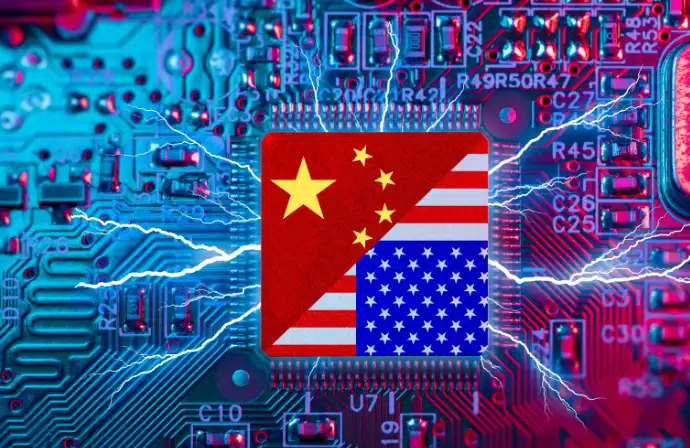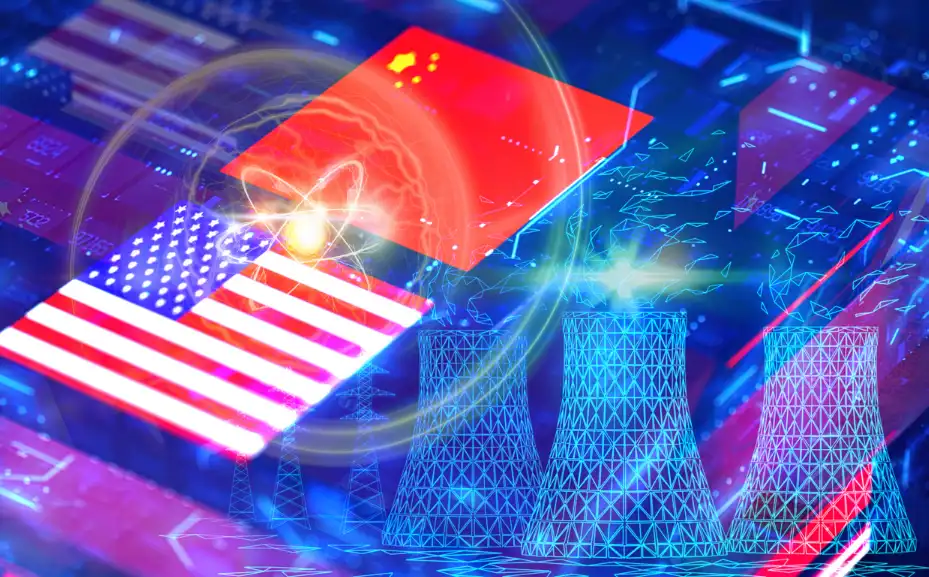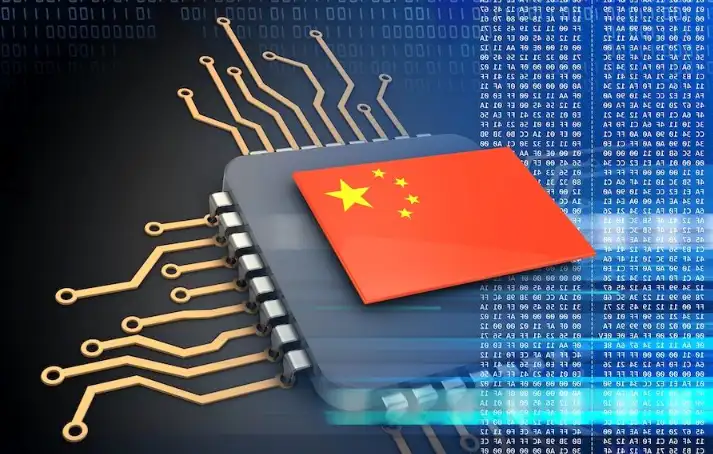The U.S.-China AI race nuclear power front is intensifying. AI data centers require vast, stable electricity, and nuclear power — from large reactors to small modular reactors (SMRs) — offers the most reliable solution. Control over nuclear energy could determine leadership in artificial intelligence.
KumDi.com
The U.S.–China AI race is no longer just about chips or algorithms — it’s about power. Nuclear power is emerging as the decisive factor, as both nations scramble to secure enough reliable energy for AI data centers. From small modular reactors to large-scale plants, nuclear could determine who leads in artificial intelligence.
For years, the competition between the United States and China in artificial intelligence has been framed around algorithms, semiconductor supply chains, and access to top talent. But a new front in this rivalry is rapidly emerging: energy. AI is not only about data and compute; it is also about electricity. Training massive AI models and running global-scale inference systems require immense amounts of reliable, continuous power. The next battleground in the U.S.–China AI race may not be the chip factory or the research lab, but the nuclear reactor.
Table of Contents

Why AI Demands Massive Energy
Artificial intelligence consumes far more energy than traditional computing. Training frontier models requires clusters of GPUs and specialized chips running non-stop for weeks or months. These training runs can consume as much electricity as small cities. Once models are deployed, inference — the process of delivering real-time AI outputs for billions of users — adds another continuous layer of energy demand.
Cloud providers, data centers, and AI companies are already confronting energy bottlenecks. In some regions, local grids cannot supply the high-density, uninterrupted electricity that hyperscale AI campuses need. As demand grows, the question is no longer whether AI has enough chips, but whether it has enough power.
Why Nuclear Power Fits AI’s Needs
Among all energy sources, nuclear stands out as a strategic solution. It provides:
- Continuous baseload power: Unlike wind and solar, nuclear reactors can operate nearly 24/7 at full capacity.
- Low-carbon credentials: Nuclear aligns with net-zero goals, making it attractive to governments and corporations.
- High energy density: A relatively small footprint can generate vast amounts of electricity, perfect for land-constrained data center regions.
For AI workloads that cannot tolerate fluctuations or outages, nuclear power provides stability unmatched by most alternatives.
The Role of Small Modular Reactors (SMRs)
A new wave of nuclear technology, known as small modular reactors, is gaining attention in the AI sector. Unlike traditional gigawatt-scale reactors that take years to build, SMRs are factory-fabricated and can be deployed faster and closer to demand centers.
Data centers located near SMRs could tap into a dedicated, reliable, low-carbon power supply. SMRs also offer scalability: companies can add modules as their AI workloads expand. This modular approach could redefine how energy infrastructure supports AI development in the coming decade.
China’s Nuclear Acceleration
China has recognized the importance of energy for its digital and AI ambitions. Through state-led planning and financing, China has accelerated nuclear construction at a pace far exceeding most other nations. Dozens of reactors are under construction or planned, and the country is aggressively developing indigenous SMR and advanced reactor technologies.
This rapid buildout positions China to provide its domestic AI industry with abundant, stable power. It also creates a platform for exporting nuclear technology alongside AI solutions, deepening influence abroad. Energy security, in this context, becomes both a domestic advantage and a tool of geopolitical strategy.
The U.S. Approach: Innovation and Private Capital
The United States, while slower in new reactor construction, brings strengths in innovation, private investment, and public-private partnerships. Federal initiatives are seeking to modernize licensing, incentivize nuclear startups, and support next-generation designs. At the same time, major technology companies are entering direct partnerships with nuclear developers.
For example, cloud providers and AI firms are exploring long-term power purchase agreements with nuclear plants, or even co-investing in new nuclear projects near data center hubs. These moves aim to secure energy independence from volatile fossil markets and constrained local grids.
Barriers to Rapid Deployment
Despite its promise, nuclear faces real challenges:
- Regulatory hurdles: Licensing and safety approvals can take years.
- Public perception: Local opposition and safety concerns remain strong.
- High upfront costs: Financing nuclear projects, especially first-of-a-kind SMRs, is capital-intensive.
- Supply chain constraints: Skilled labor, reactor-grade materials, and specialized components are not instantly scalable.
Unless these barriers are reduced, nuclear may not expand quickly enough to keep pace with the explosive growth of AI energy demand.
Why Renewables Alone May Not Be Enough
While solar, wind, and batteries are critical to a sustainable energy mix, they struggle to fully meet AI’s unique requirements. Large-scale AI training demands round-the-clock power for weeks at a time. Battery storage can smooth short fluctuations, but storing energy at the scale required for multi-week AI workloads remains technically and economically daunting. Nuclear, therefore, provides a unique complement to renewables by guaranteeing uninterrupted baseload power.
Big Tech’s Energy Hedging Strategies

The world’s largest AI companies are not waiting passively. They are actively securing future energy supplies through:
- Long-term nuclear contracts to lock in decades of low-carbon power.
- Direct investment in reactor startups and SMR developers.
- On-site generation strategies, where companies seek to build or co-own reactors adjacent to data centers.
By hedging against energy insecurity, these firms aim to ensure that AI development is not constrained by grid limitations or price volatility.
Geopolitical Stakes of Energy and AI
The intersection of AI and nuclear power extends beyond economics. Energy-backed AI capacity is a matter of national power. Countries that can supply abundant, reliable electricity for AI will shape not only domestic innovation but also global influence.
China’s state-driven model allows it to rapidly align nuclear policy with AI goals. The United States, while more decentralized, leverages private sector dynamism and international alliances. This divergence could create contrasting models of AI-energy integration, with implications for global competition, trade, and security.
Ethical and Security Concerns
Expanding nuclear power for AI raises broader questions:
- Waste management: How will nations handle long-lived nuclear waste as reactors multiply?
- Safety: Can new designs prove themselves safe enough for wide public acceptance?
- Proliferation risks: As more countries adopt nuclear tech, the risk of dual-use concerns grows.
- Centralization of power: Concentrating AI capacity around nuclear projects could magnify corporate and governmental control.
These issues must be addressed to ensure that nuclear-backed AI growth does not compromise safety, equity, or international stability.
Looking Ahead: Signals to Watch
Several developments will determine how quickly nuclear becomes central to AI:
- Commercialization of SMRs — The speed at which modular reactors move from prototype to mass deployment.
- Tech-nuclear partnerships — Deals between AI firms and energy providers that set the template for future data centers.
- Government incentives — Policies that reduce licensing times and de-risk investment.
- International nuclear exports — Whether China or the U.S. couples nuclear technology with AI offerings abroad, shaping influence in emerging markets.
Conclusion: The Energy-AI Nexus
The U.S.–China race in artificial intelligence is entering a new phase where kilowatts may matter as much as algorithms. Nuclear power — with its ability to provide continuous, low-carbon energy at scale — is emerging as the decisive factor in whether nations can sustain AI growth.
For China, aggressive state-led nuclear expansion provides a near-term advantage. For the U.S., innovation, private capital, and international collaboration form the response. Ultimately, the side that secures the most reliable and scalable energy sources may define the balance of power in the age of artificial intelligence.

FAQs
Why is nuclear power important in the U.S.–China AI race?
Nuclear power provides continuous, low-carbon electricity needed for AI data center energy. It ensures reliability and scale, giving either the U.S. or China an edge in artificial intelligence.
How do small modular reactors (SMRs) support AI development?
SMRs offer flexible, factory-built nuclear solutions that can be deployed near AI data centers. They deliver stable energy, helping overcome power shortages in the U.S.–China AI race nuclear power competition.
Is China ahead of the U.S. in nuclear energy for AI?
Yes. China’s nuclear expansion has outpaced the U.S., giving it more energy security for AI data center energy demands. This strengthens its position in the U.S.–China AI race nuclear power rivalry.
Can renewable energy replace nuclear for AI workloads?
Renewables are vital but intermittent. AI requires constant, high-density energy. Without nuclear power, renewables alone cannot fully sustain AI data center energy in the U.S.–China AI race.
What role does U.S. innovation play in nuclear power for AI?
The U.S. leverages private capital and advanced SMR technology to compete with China. These efforts aim to boost nuclear power for AI and reduce gaps in the U.S.–China AI race.




